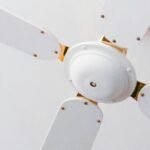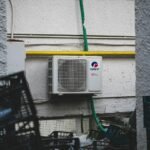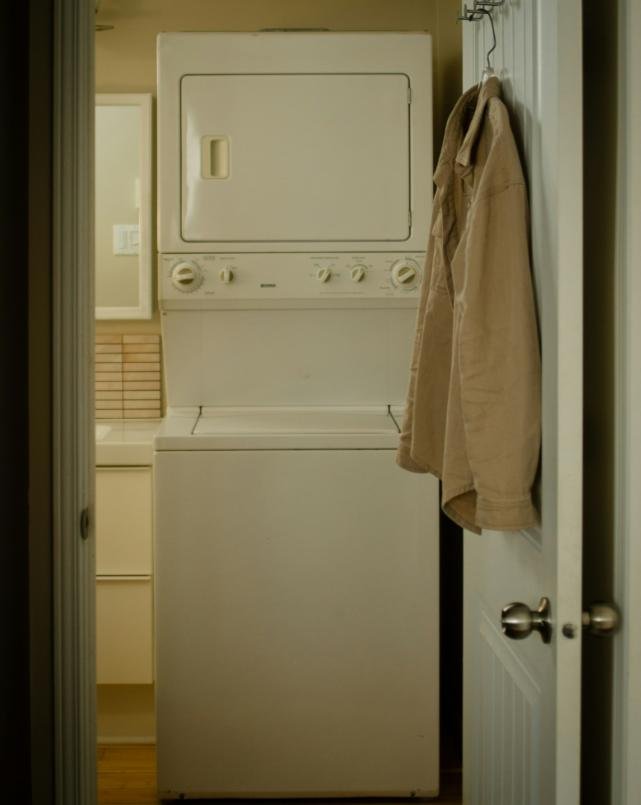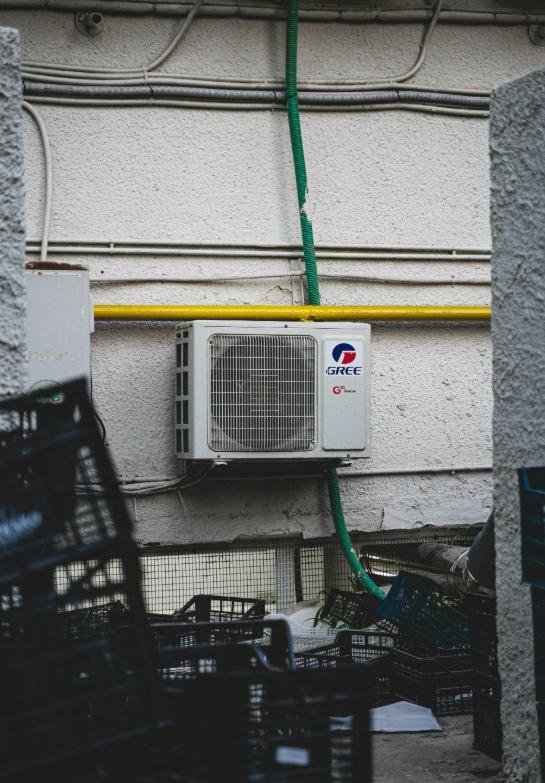Table of Contents
Understanding Condenser Tumble Dryers
A condenser tumble dryer is a type of laundry appliance that removes moisture from clothes through a process of condensation rather than expelling hot, humid air outside. In contrast to vented dryers, which require external exhaust systems, condenser dryers operate by capturing the moisture released during the drying cycle in a water reservoir. This technology allows for more flexibility in placement, as these dryers can be installed in locations without direct access to an exterior vent. The fundamental principle behind condensation drying involves the use of a heat exchanger, which cools the air circulated through the drum, converting moisture into water droplets that are collected in the reservoir.
The benefits of using a condenser dryer extend beyond the convenience of installation. These appliances are generally more energy-efficient, as they do not require additional energy to vent air outside. Moreover, they help maintain a steady indoor climate since they do not release humid air into living spaces. For households with limited outdoor space, such as apartments or small homes, condenser tumble dryers provide a practical solution without compromising on performance. They are designed to offer versatile drying options, including sensor drying technology that automatically detects moisture levels, ensuring clothes are not over-dried and preserving their integrity over time.
Common applications of condenser tumble dryers can be observed in diverse household settings. They are ideal for busy families needing efficient laundry turnaround or for individuals who prefer a low-maintenance drying solution. With their capability to function in various environments, condenser dryers serve as an essential tool in modern home management, making them highly regarded among consumers seeking convenience without the need for extensive installations. By understanding the workings and advantages of these appliances, users can make informed decisions when it comes to enhancing their laundry processes.
Preparation for Installation
Preparing for the installation of a condenser tumble dryer is a critical step to ensure a smooth setup and effective operation. The first task is to assess the available space where the dryer will be located. It is important to select a well-ventilated area that provides easy access for loading and unloading laundry. Consideration should also be given to the proximity to a power outlet and drainage options, as most condenser dryers require both electrical and water connections.
Next, measuring the dimensions of the selected area is essential. This includes determining the height, width, and depth to ensure that the condenser dryer fits comfortably within the space. It is advisable to leave some clearance around the unit for proper air circulation, maintenance, and future access. Users should also account for the space needed for opening the dryer’s door fully.
Additionally, check the electrical outlets available in your home. The condenser dryer should be connected to a suitable power supply that meets the manufacturer’s voltage requirements. If the outlet layout is insufficient, you may need to consult a qualified electrician for further assistance.
Finally, consider any additional tools or materials that may be necessary for installation. Basic tools such as a level, screwdrivers, and a wrench may be required for securing connections. Furthermore, having a user manual on hand can be beneficial for step-by-step guidance during the installation process. Ensuring that these preparations are carried out thoroughly will streamline the installation and enhance the functionality of your condenser tumble dryer.
Required Tools and Equipment
Installing a condenser tumble dryer requires a systematic approach and an array of essential tools and equipment. Ensuring that you have the right items at hand not only facilitates a smoother installation but also helps in adhering to safety protocols, minimizing potential damage to the appliance or property.
Primarily, basic hand tools are necessary for most installations. These include a set of screwdrivers, both Phillips and flat-head, to assist with securing brackets and fittings. A pair of pliers is crucial for gripping components and making adjustments as needed. Additionally, a level will help ensure that the dryer is installed on a flat surface, preventing any operational issues during use.
Moreover, a socket wrench set can prove invaluable when dealing with various nut sizes commonly found in the unit’s assembly. Depending on the model you own, a tape measure may be required to confirm that the dryer fits appropriately in its intended space, as well as to measure any venting or plumbing that may accompany the unit. A utility knife can also be useful for opening packaging or cutting through any material that may obstruct the installation.
For those looking to streamline the process, some optional tools could enhance efficiency. A cordless drill with a drill bit set can speed up the installation of screws and make the entire process less labor-intensive. Furthermore, a vacuum cleaner may help in clearing away any debris resulting from the installation, ensuring a clean work area when the job is completed.
Having a checklist of these tools and equipment, both essential and optional, can make the installation of your condenser tumble dryer not only feasible but also efficient, paving the way for optimal functionality in your laundry routines.
Choosing the Right Location
When selecting a location for installing a condenser tumble dryer, several crucial factors must be taken into consideration to ensure optimal functionality and convenience. One of the primary aspects to evaluate is the proximity to your washing machine. Ideally, placing the dryer near the washer can minimize the time and effort required for transferring laundry. A short distance between the two appliances also reduces the risk of holding wet clothes too long, which can lead to bad odors or mildew.
Accessibility is another vital factor when determining the installation site. The dryer should be positioned in a location that allows for easy loading and unloading of clothes. This is particularly important if the unit is front-loading, as the doors need ample space to open fully. Additionally, consider how often you will use the dryer; placing it in an easily accessible area can enhance your laundry routine and increase the likelihood of regular use.
Ventilation is crucial for the efficient operation of a condenser tumble dryer. Unlike vented dryers that expel hot, moist air outside, condenser dryers convert moisture into water, which is stored in a tank. Despite this difference, proper airflow is still important to prevent overheating and ensure effective drying. It is advisable to choose a location with adequate space around the unit to facilitate air circulation. Furthermore, areas with excessive humidity, such as basements without airflow, may hinder the dryer’s performance.
Lastly, consider the space required for maintenance and repairs. Selecting a location with sufficient clearance around the dryer allows for easy access to the machine’s components. This can expedite maintenance tasks such as cleaning the filter or troubleshooting minor issues. By taking these factors into account, you can ensure that your condenser tumble dryer operates efficiently and seamlessly integrates into your laundry routine.
Electrical Requirements
When installing a condenser tumble dryer, it is crucial to understand the electrical requirements to ensure safe and efficient operation. Typically, modern condenser dryers are designed to operate on a standard voltage of 230V, which is the common voltage supplied in most households. However, it is important to verify the dryer’s specifications before installation, as variations can exist between different models and manufacturers.
In addition to voltage requirements, the electrical circuit must be adequately rated to handle the dryer’s power consumption. Most condenser dryers have a power requirement ranging from 2,000 to 3,000 watts. Therefore, it is recommended to have a dedicated circuit, typically rated at a minimum of 13 amps, to avoid overloads and potential tripping of circuit breakers. When assessing the electrical circuit, consider the total load of other appliances operating on the same circuit to ensure there is no risk of exceeding the circuit’s capacity.
Safety is of paramount importance when working with electrical installations. It is advisable to engage a qualified electrician to carry out the installation, especially if there are uncertainties regarding the existing wiring or circuit ratings. A professional will be able to assess whether the home’s electrical system is suitable for the installation and can make necessary upgrades if required. Additionally, ensuring that the dryer is connected to an RCD (Residual Current Device) can provide an additional safety measure against electric shocks.
Finally, following local regulations and guidelines is essential when installing appliances like a condenser tumble dryer. Familiarize yourself with any permits or certifications that may be required in your area. By paying careful attention to the electrical requirements and prioritizing safety, homeowners can enjoy the convenience of their new tumble dryer without complications.
Installing the Condenser Tumble Dryer
Installing a condenser tumble dryer requires careful attention to detail to ensure optimal performance and safety. The first step is to select an appropriate location for your dryer. Ensure the area is well-ventilated and provides sufficient clearance around the machine for airflow. Once you have identified a suitable spot, begin by leveling the tumble dryer. Utilize a spirit level to confirm that it sits evenly on the floor. If needed, adjust the feet of the dryer to achieve stability, which will help to minimize vibrations during operation.
After the dryer is level, proceed to connect it to a power source. Confirm that the electrical outlet is suitable for the appliance’s voltage and amperage specifications. If in doubt, consult a qualified electrician. Use a power cord that meets the manufacturer’s guidelines and ensure that it is plugged securely into the outlet. This step is crucial to prevent electrical hazards and operational issues. Ensure that the dryer’s power cord is not damaged or frayed as this can lead to safety concerns.
Next, check if any assembly is required before use. Some models may come with additional components for secure operation, such as adjustable exhaust hoses or filters that need to be attached. Refer to the product manual for specific instructions on how to properly execute this assembly. As you set up the machine, be cautious of common installation pitfalls such as insufficient space for the tumble dryer to breathe or overlooking the importance of proper airflow clearance.
Once the dryer is fully set up and connected, consider running a short test cycle to verify functionality. This step will help identify any installation issues before regular use begins. By following these guidelines, you will ensure a seamless installation process, pave the way for efficient drying, and extend the life of your condenser tumble dryer.
Setting Up the Water Tank and Drainage
Installing a condenser tumble dryer involves configuring the water tank and drainage system properly to ensure optimal performance. The condenser dryer collects moisture from your clothes into a water tank. First, identify the location of your dryer, as this will influence your setup for drainage options. If you prefer to manually empty the water tank, ensure it is easily accessible. However, for more convenience, you can opt to connect the dryer directly to a drainage system.
To set up the water tank for condensation collection, locate the tank, which is typically found at the front or rear of the machine. Depending on the model, you may need to twist and lift the tank to remove it. Fill the tank to the maximum recommended limit with water before testing the dryer to ensure that it operates correctly. After accessing the tank, empty it regularly to prevent overflow, enhancing your dryer’s performance. Cleaning the tank is essential as well; rinsing it out every few months can help maintain optimal function.
If you decide to connect the tumble dryer to a drainage system, you will need a suitable drainage hose, which generally comes with the appliance. Attach one end of the drainage hose to the dryer’s outlet and the other end into a suitable drainage point, such as a sink or a dedicated drain. Ensure there are no kinks in the hose, as this can impede the flow of water. Finally, double-check fittings for leaks before starting the dryer. Regular maintenance of the drainage system, including periodic cleaning of the hose, will prevent build-up and ensure optimal efficiency.
Testing the Installation
After successfully installing your condenser tumble dryer, it is crucial to conduct a thorough testing procedure. This step guarantees that the unit operates correctly, safely, and efficiently, confirming that all connections and components are functioning as intended. Begin by plugging the dryer into the power outlet and ensuring that it is securely connected. Verify that the electrical supply is stable, as fluctuations can affect the performance of the appliance.
Next, initiate a test run by selecting a suitable drying program. It is advisable to start with a cycle that requires a moderate duration, allowing you to observe the machine’s operation closely. During the test run, pay attention to a few vital elements: listen for any unusual noises, check for vibrations, and assess the effectiveness of the drying cycle. A well-installed dryer should operate quietly and without excessive movement.
Throughout the cycle, monitor the condensation container, if applicable, or ensure that the venting system is devoid of blockages. Proper airflow is essential for the dryer’s efficiency and effectiveness. Once the test cycle is complete, inspect the laundry to ascertain that the items are thoroughly dried. If you encounter excessive moisture in the clothes or notice poor performance, it is essential to troubleshoot the problem.
Common issues might include incorrect settings, improper loading, or airflow restrictions. Consult the user manual for guidance on how to adjust settings or address common problems. If the dryer fails to work correctly after attempting these solutions, contacting customer service or a professional technician may be necessary to resolve the issue. Ensuring that your condenser tumble dryer functions optimally not only enhances performance but also prolongs the life of the appliance.
Maintaining Your Condenser Tumble Dryer
Regular maintenance of your condenser tumble dryer is crucial to ensure its optimal performance and longevity. One of the foremost tasks is cleaning the filter after every use. The lint filter is designed to capture loose fibers and debris from your clothes, and a clean filter allows for efficient airflow, which enhances drying efficiency. To clean the filter, simply remove it from its compartment, brush off the lint, and rinse it under warm water to eliminate any remaining particles. After washing, allow it to dry completely before reinserting it into the dryer.
In addition to the lint filter, regularly checking and emptying the water tank is essential for the efficient operation of your condenser tumble dryer. After each drying cycle, inspect the tank and drain any collected water. A full tank can prevent optimal functioning and may trigger automatic shut-off mechanisms to protect the dryer from malfunction. It is advisable to periodically clean the water tank to prevent the buildup of limescale or detergent residue, which can impede its performance over time.
Moreover, ensuring that the condenser unit remains clean is vital for maintaining performance. Many models have a removable condenser that can be washed under running water. Consult your user manual for specific instructions on your model’s maintenance. Lastly, it is beneficial to perform a visual inspection of the appliance and its exhaust vents. Look for any blockages or damage that may affect airflow or efficiency. Regular checks will help detect issues before they escalate into larger problems, ensuring your condenser tumble dryer remains both energy-efficient and effective in drying your laundry.







